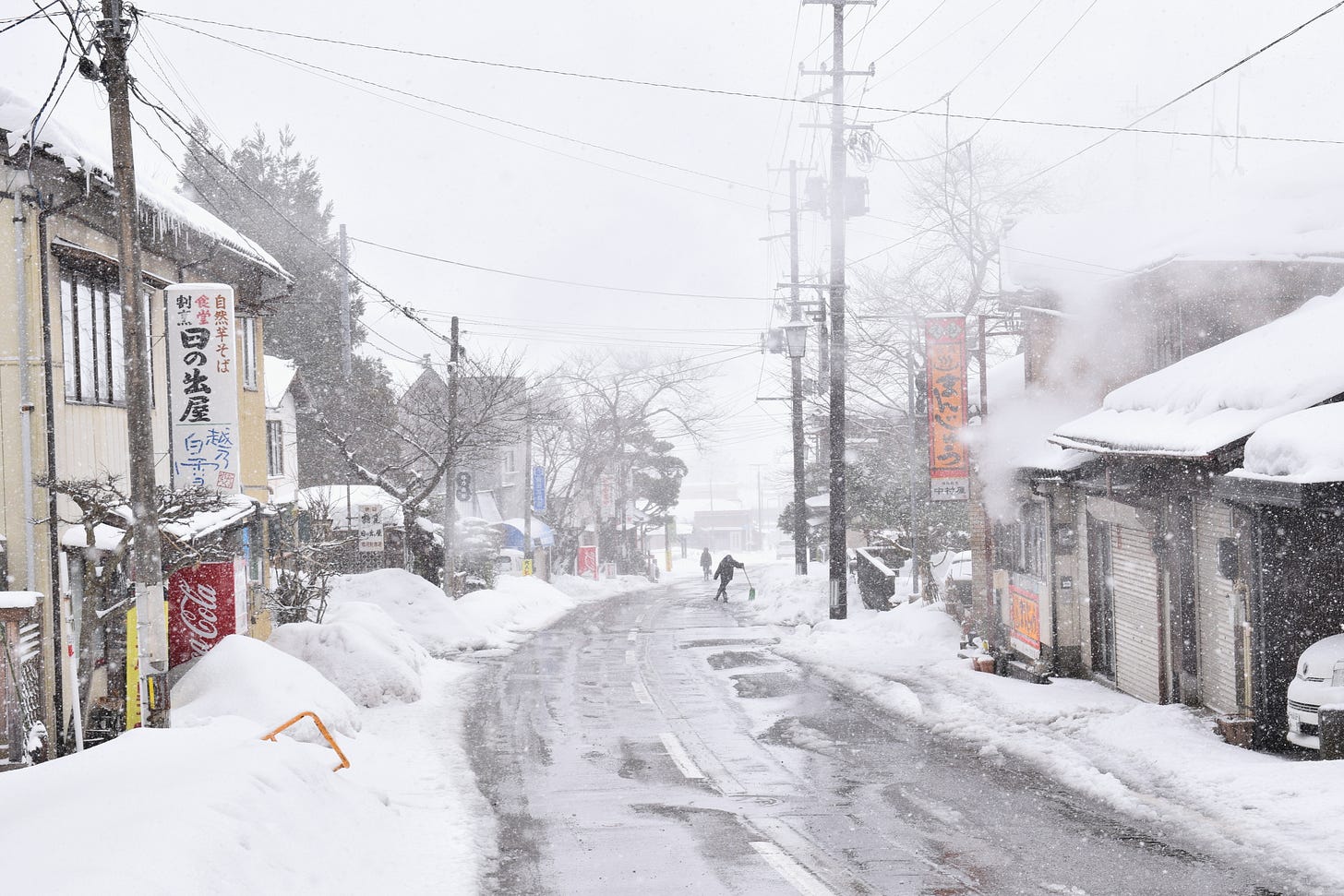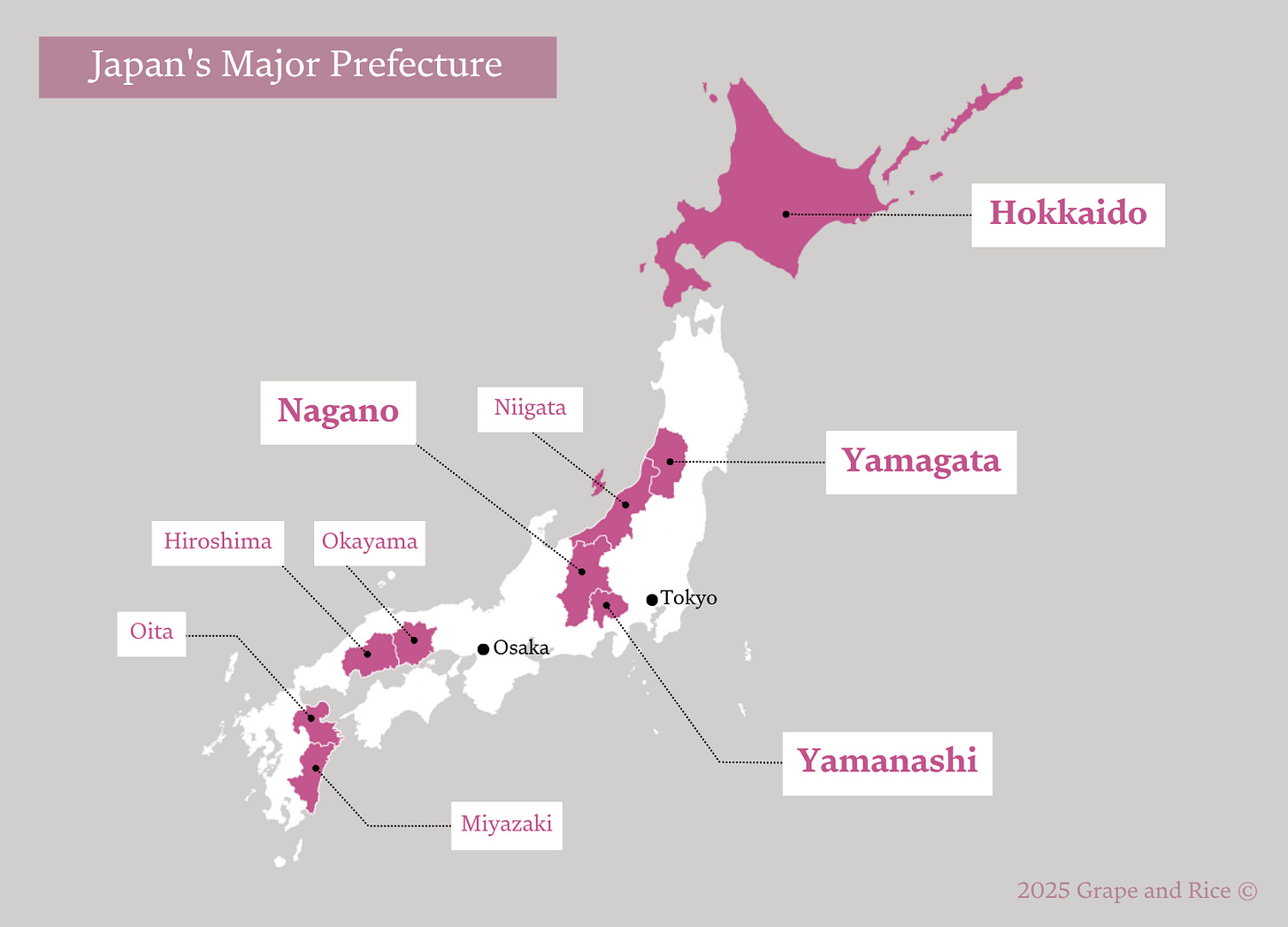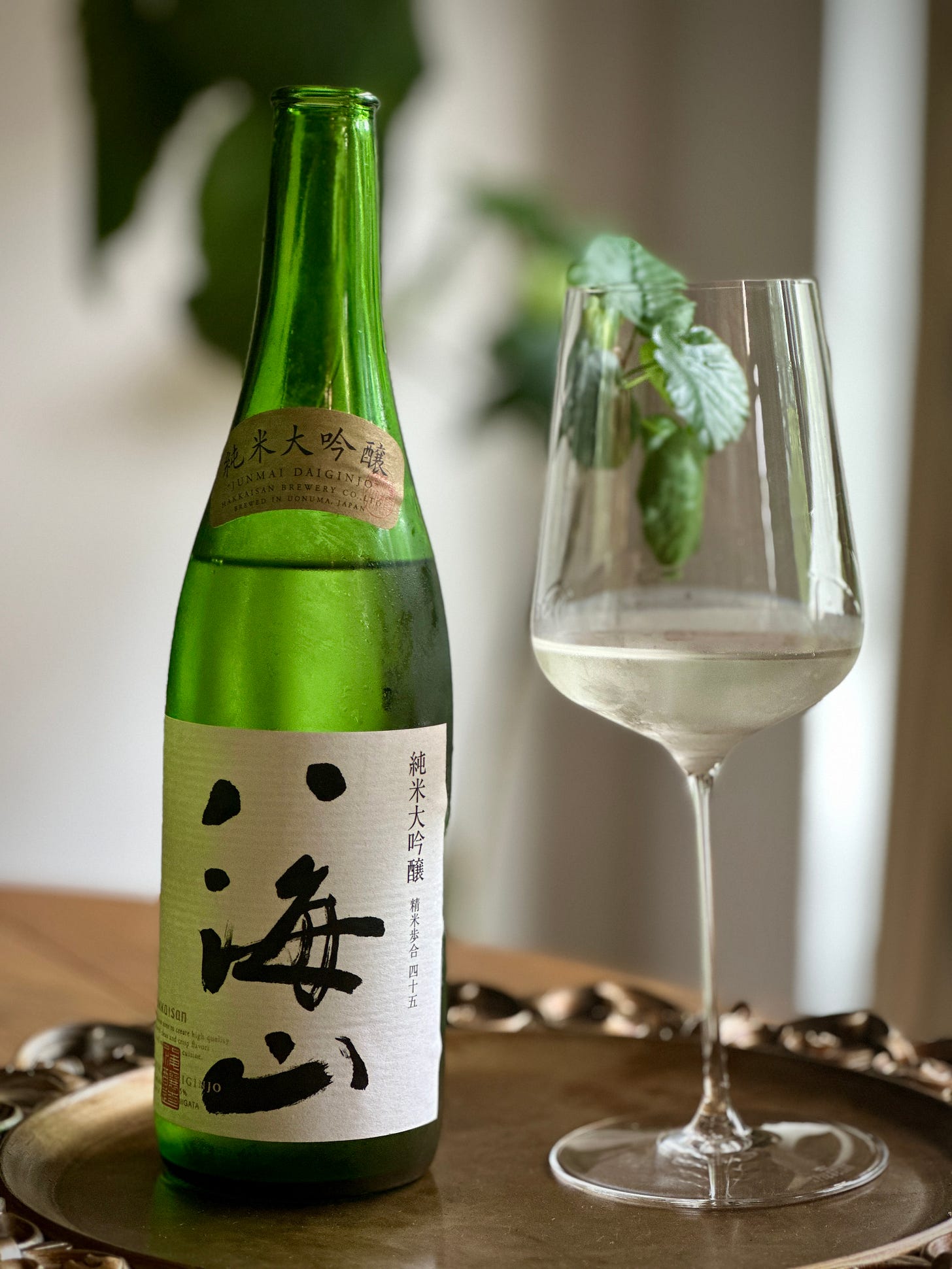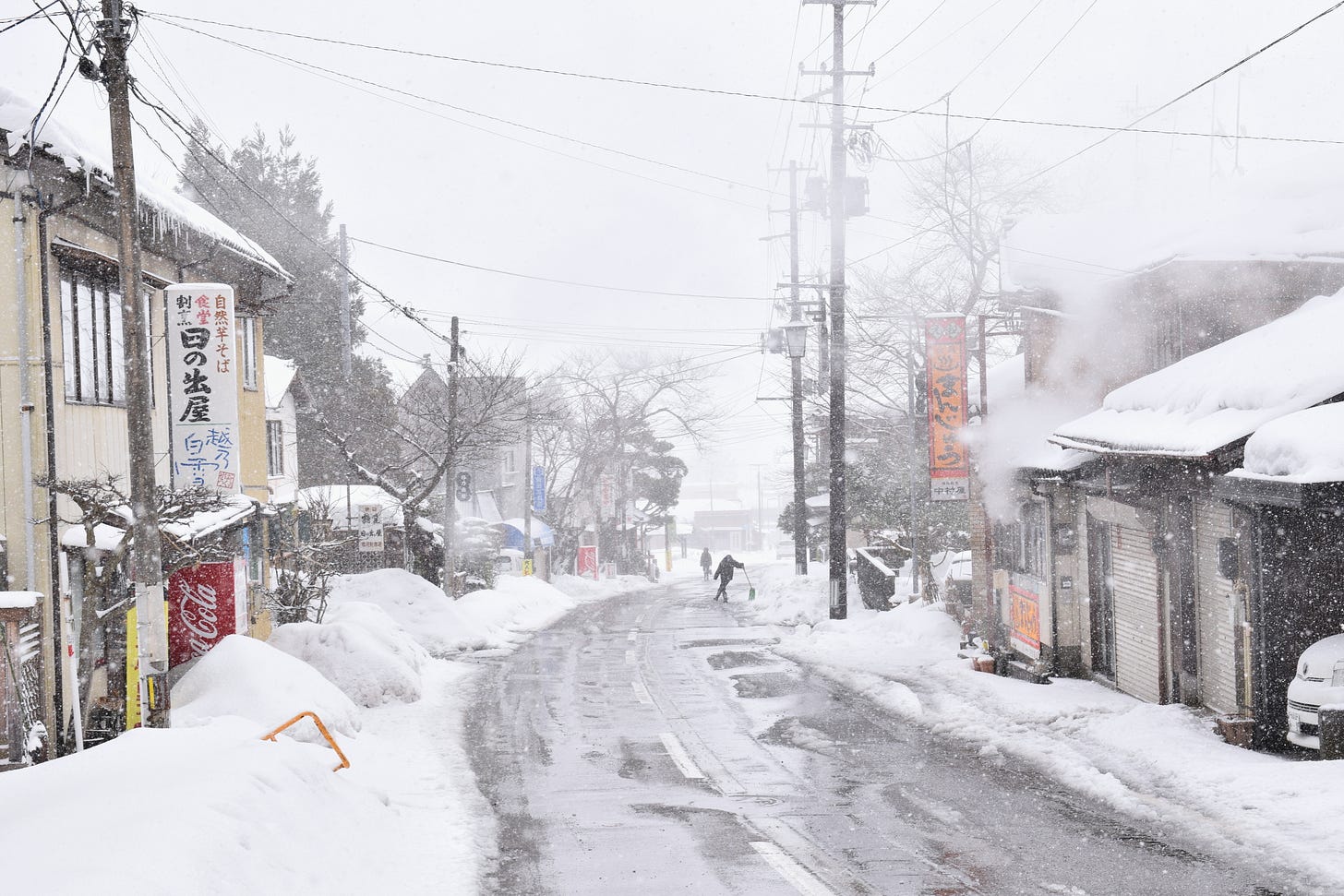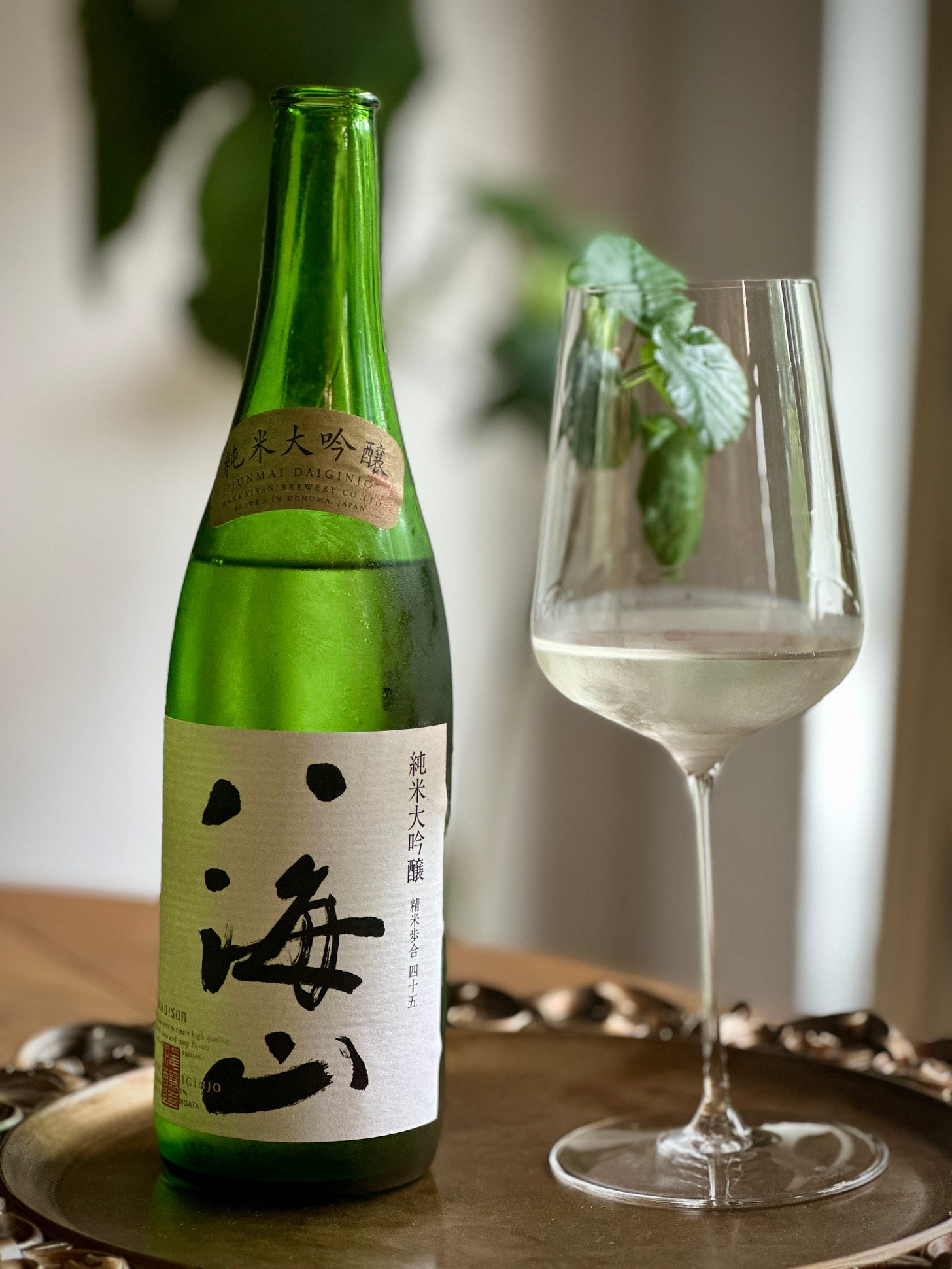Sake Atlas #2: Niigata Prefecture - Where Snow Becomes Poetry
**🇯🇵 日本語版は記事の下部にあります / Japanese version available below**
This is part of our comprehensive guide exploring Japan's 20 most important sake-producing regions, helping sake enthusiasts understand how geography and local traditions shape each area's unique brewing style. Today, we explore Niigata Prefecture—the heartland of Tanrei Karakuchi.
I'm Kazumi, a DipWSET wine and sake educator based in Amsterdam. With roots in Japanese and European food cultures, I write this post to bridge the gap, translating sake into the language of wine professionals. Each week, I explore one topic to demystify sake, deepen your understanding, and equip you with practical language for the floor or table.
The Land Where Winter Writes in Water
Some decades ago, I knew Niigata for one thing: powder snow, making annual pilgrimages from Tokyo with my snowboard to chase the deep powder of Echigoyuzawa and Naeba. Now, I virtually return for something even more captivating—this particular style of Japanese sake.
Picture: It's February in Niigata Prefecture, and the world has disappeared under a blanket of snow so deep that houses seem to float like islands in a white ocean. The silence is profound, broken only by the occasional creak of bamboo bending under winter's weight. But beneath this frozen surface, something extraordinary is happening. The snow—up to four meters deep in some places—is slowly transforming into what sake lovers around the world recognize as liquid poetry.
Welcome to Niigata Prefecture, Japan's undisputed sake kingdom. With 101 breweries—No. 1 in Japan—scattered across its snow-covered landscape, Niigata produces more high-quality sake (specially designated sake) than any other prefecture in Japan. But numbers alone don't tell the story. What makes Niigata special isn't just quantity—it's the revolutionary philosophy that emerged from these snowy valleys and fundamentally changed how the world thinks about sake.
This is the birthplace of tanrei karakuchi—light-bodied, dry sake that cuts through the palate like a mountain breeze. Clean, crisp, and impossibly pure, this style didn't just define Niigata's identity; it sparked Japan's ginjo-shu boom in the 1980s and rewrote the rules of sake appreciation. In a country where sake was once heavy, sweet, and often rough, Niigata whispered a different possibility: What if sake could be as clean and refreshing as the snowmelt that nourishes it?
The Geography of Perfection
Niigata sits like a crescent moon along Japan's western coast, its face turned toward the Sea of Japan, its back pressed against the mountains that trap the winter storms rolling in from Siberia. This positioning isn't just geographic coincidence—it's the foundation of everything that makes Niigata sake extraordinary.
The prefecture's relationship with winter is intimate and essential. When those Siberian storms slam into the Japanese Alps, they dump snow with religious regularity. The locals have learned to read the sky like a sacred text, knowing that each snowflake carries the promise of next year's sake. This isn't just weather—it's the slow, patient process of creating the world's purest brewing water.
The melting snow doesn't rush toward the sea; instead, it seeps slowly through layers of ancient rock and mineral-rich soil, emerging months later as crystalline spring water. This natural filtration system creates water so pure that it becomes the invisible backbone of every bottle of Niigata sake. In addition to the abundant melting water, Niigata's fertile clay soil, blessed with abundant nutrients, has earned the region its nickname: "The Land of Rice."
It's the perfect storm of geography, climate, and time. The Sea of Japan provides humidity and temperature regulation, while the mountains create the natural barrier that traps the snow and moderates the climate. The result is a brewing environment so ideal that it seems designed by sake gods themselves.
Pioneers of the Craft
Niigata's sake story isn't just one of natural gifts—it's a tale of innovation and determination. The prefecture was quietly revolutionizing sake production with a combination of scientific rigor and artistic vision.
Central to this story are human, the Echigo Toji¹ , the legendary guild of master brewers who elevated Niigata sake to art form. These craftsmen, part of one of Japan's three great brewing guilds, carried their knowledge like sacred flame from brewery to brewery, season to season. Their techniques, passed down through generations, created the foundation for what would become the distinctive Niigata style.
Additionally in the early 20th century when Niigata established Japan's first prefecture-level Sake Brewing Laboratory. This laboratory became the birthplace of techniques that would eventually spread throughout Japan, establishing Niigata as the intellectual capital of sake brewing, including the development of Gohyakumangoku rice in 1950s.
Gohyakumangoku, whose name literally means "five million koku" (referring to the prefecture's rice production capacity), has large grains and low protein content made it perfect for the polished, refined styles that would become Niigata's signature.
Recognition reached its pinnacle in 2022 with the designation of GI Niigata—a geographic indication that officially acknowledged what sake lovers had known for decades: Niigata sake occupies a unique and protected place in the world of Japanese brewing.
¹ Toji System: The traditional Japanese master brewer system where skilled craftsmen (toji) lead seasonal brewing teams. The three major toji guilds are Echigo Toji (Niigata), Nanbu Toji (Iwate), and Tanba Toji (Hyogo). These masters typically work seasonally, traveling between breweries during winter brewing season, carrying centuries-old techniques and maintaining quality standards across different sake producers.
The Philosophy of Tanrei Karakuchi
To understand Niigata sake, you must first understand tanrei karakuchi—a phrase that translates roughly as "light-bodied and dry" but encompasses a philosophy that revolutionized Japanese brewing.
The concept emerged from Niigata's unique relationship with its environment. The pristine snowmelt water naturally lends itself to clean, crisp sake. Tanrei karakuchi challenged everything the sake world thought it knew. Before Niigata's revolution, sake was often heavy, sweet, and warming—perfect for cold winters but limiting in its applications. Niigata proposed something radically different: sake that could be as refreshing as water, as clean as mountain air, and as versatile as wine.
This philosophy became the driving force behind Japan's ginjo-shu boom in the 1980s. Ginjo sake, with its high polish ratios and delicate flavors, found its perfect expression in Niigata's approach. The region's brewers discovered that their clean water and refined techniques could create sake of unprecedented elegance and complexity.
The style reflects more than just technical innovation—it embodies a cultural shift. In a Japan modernizing rapidly after World War II, Niigata sake offered sophistication without ostentation, complexity without confusion. It was sake for a new generation, approachable yet profound, traditional yet thoroughly modern.
Recently, the style has become more diversified, yet you will find the philosophy of tanrei karakuchi in each sake.
Featured Japanese Sake: Hakkaisan
Among Niigata's pantheon of exceptional sake, Hakkaisan stands as perhaps the most eloquent expression of everything that makes this prefecture special. Named after the sacred mountain that watches over the brewery, this sake embodies the tanrei karakuchi philosophy while pushing the boundaries of what refined sake can achieve.
The Producer
Hakkaisan Brewery was founded in 1922 by Koichi Nagumo in Minamiuonuma City, Niigata Prefecture, at the foot of sacred Mount Hakkaisan. The brewery celebrated its 100th anniversary in 2022, establishing itself as one of Japan's most respected sake producers. What sets Hakkaisan apart is their unwavering commitment to the "tanrei karakuchi" style—a clean, dry sake that perfectly complements food rather than competing with it.
Hakkaisan's philosophy rests on three cornerstones: bringing out the essence of good materials with every possible effort, delivering quality sake to as many people as possible, and honoring their blessed land. They believe the highest quality sake should have fuller body yet remain clear and smooth, never interfering with food. Their commitment to maintaining small batch production of just three tons of rice per tank ensures they never compromise quality for quantity, even as they strive to make premium sake accessible to a wider audience.
Production Method
Hakkaisan's Junmai Daiginjo combines carefully selected Yamada Nishiki, Gohyakumangoku, and Miyamanishiki rice polished to 45% with the legendary ultra-soft clean water, "Raidensama no Shimizu" spring water from Mount Hakkaisan. Koji-making is their key, so all processes are taken place by hand, followed by the Ginjo method of slow fermentation at low temperatures, allowing rice's natural umami to develop while maintaining the brewery's signature clean, elegant character. Learn more about sake brewing process to understand how this meticulous attention to water quality and fermentation creates Hakkaisan's distinctive balance. Check out this post to support your basic knowledge.
Tasting Notes
Crystal clear appearance with a beautiful transparent quality that captures light elegantly.
Delicate floral notes, subtle pear, clean rice and cotton candy aromas. Exceptional balance on the palate, featuring elegant rice umami, gentle fruit notes of white peach and apple, supported by crisp acidity that keeps the sake refreshing and food-friendly. Ginjo style yet this sake doesn't rely only on the fruity floral aromas, but has body, texture, umami on the palate. Signature clean finish, lingering rice sweetness and a dry, crisp conclusion that invites the next sip without overwhelming the palate. Outstanding.
Recent Developments
Hakkaisan has been making significant international strides recently, including a high-profile partnership agreement with the Los Angeles Dodgers to create special collaboration products and expand sake's global potential. The brewery has also entered into a capital alliance with Brooklyn Kura in New York, supporting American sake production while exploring the possibility of launching Hakkaisan products made in the United States. How exciting it is to see traditional Japanese craftsmanship inspiring sake production on American soil!
Ready to experience this century-old tradition in your glass? Seek out Hakkaisan Junmai Daiginjo at your local premium sake retailer and discover why this perfectly balanced sake has earned devotion from food lovers worldwide.
雪解け水に恵まれた土地:新潟
これは日本の20の重要な日本酒生産地域を探るガイドの一部で、地理と地域の伝統が各地域独特の醸造スタイルをどのように形作るかを海外の日本酒愛好家に理解してもらうため、JSAとWSETの知識および公式サイトの情報等を元に作っています。今日は新潟県—現代日本酒文化の中心地を探ります。
数十年前、私にとって新潟といえば一つのことしか意味しなかった。パウダースノー。スノーボードを持って東京から毎年巡礼のように通い、越後湯沢や苗場の深いパウダーを追い求めていた。今、私がバーチャルに戻るのは、さらに魅力的な何か—この特別な日本酒のスタイルのためである。
こんな場面を想像してほしい。2月の新潟県、世界は雪の毛布の下に消え去り、その深さは家々が白い海に浮かぶ島のように見えるほどである。静寂は深遠で、時折竹が冬の重みに耐えかねて軋む音だけがそれを破る。しかし、この凍てついた表面の下で、特別なことが起こっている。場所によっては4メートルの深さに達する雪が、世界中の日本酒愛好家の求めるものへとゆっくりと変化しているのである。
新潟県、日本の紛れもない日本酒王国へようこそ。雪に覆われた風景に散らばる101の醸造所(日本最多)を擁する新潟は、日本のどの県よりも多くの高品質日本酒(特定名称酒)を生産している。しかし、数字だけではその物語を語れない。新潟を特別にしているのは量だけではない—これらの雪深い谷から生まれ、世界の日本酒観を根本的に変えた革命的哲学なのである。
ここは淡麗辛口の発祥地、山風のように口中を切り抜ける軽やかで辛口の日本酒が造られる。清潔で、キリッとしていて、驚くほど純粋なこのスタイルは、新潟のアイデンティティを定義しただけでなく、1980年代の日本の吟醸酒ブームに火をつけ、日本酒鑑賞のルールを書き換えた。かつて日本酒が重く、甘く、時に荒々しかった国で、新潟は異なる可能性をささやいた。日本酒がそれを育む雪解け水のように清潔で爽やかになることができるとしたら?
雪国が育む日本酒の聖地
新潟は日本の西海岸に沿って三日月のように位置し、日本海に面を向け、シベリア方面から吹き込む冬の嵐を捕らえる山々に背を押しつけている。この位置づけは単なる地理的偶然ではない—新潟の日本酒を特別なものにしている。
県と冬との関係は親密で不可欠である。シベリアの嵐が日本アルプスにぶつかるため、雪が頻繁に降る。地元の人々は空から気候を読むことを学ぶほど大変だ。とはいえ、雪が酒の8割を占める水につながる大切な存在であり、世界で最も純粋な醸造水を作り出す、ゆっくりとした忍耐強いプロセスなのであることも知っている。
雪解け水は海に向かって急ぐことはない。代わりに古代の岩石と鉱物豊富な土壌の層を通してゆっくりと浸透し、数ヶ月後に水晶のような湧水として現れる。この自然濾過システムが、新潟日本酒のすべてのボトルの見えない背骨となるほど純粋な水を作り出すのである。豊富な雪解け水に加えて、栄養豊富な新潟の肥沃な粘土質土壌は、この地域に「米どころ」という愛称も、もたらした。
これは単なる農業的偶然ではない。地理、気候、時間の完璧な嵐なのである。日本海が湿度と温度調節を提供し、山々が雪を閉じ込め気候を和らげる自然の壁を作り出している。その結果は、日本酒の神々自身によって設計されたかのように理想的な醸造環境である。
技術の先駆者たち
新潟の日本酒物語は自然の恵みだけの話ではない—革新と決意の物語である。新潟県は科学と芸術的ビジョンの組み合わせで、静かに日本酒つくりを進化させてきた。
この物語の中心にあるのは越後杜氏¹、新潟日本酒を芸術の域まで押し上げた伝説的な杜氏組合である。日本三大杜氏組合の一つである越後杜氏たちは、知識を蔵から蔵へ、シーズンからシーズンへと運んだ。世代を通じて受け継がれた彼らの技術が、新潟スタイルとなるものの基盤を作り出した。
さらに20世紀初頭、新潟は日本初の県レベル清酒専門醸造試験場を設立した。この試験場は最終的に日本全国に広がる技術の発祥地となり、1950年代の五百万石米の開発を含め、新潟を日本酒醸造の知的首都として確立した。
五百万石は、文字通り「五百万石」(県の米生産能力を指す)を意味し、大粒で低タンパク質含有量が、新潟の代名詞となる精米された洗練されたスタイルに完璧だった。
2022年のGI新潟指定で認知は頂点に達した—日本酒愛好家が何十年も知っていたことを公式に認めた地理的表示:新潟日本酒は日本酒業界で保護された地位を占めている。
淡麗辛口の哲学
新潟日本酒を理解するには、まず淡麗辛口を理解しなければならない—「軽やかで辛口」とおおまかに翻訳されるが、日本醸造を革命化した哲学を包含する言葉である。
この概念は新潟の環境との独特な関係から生まれた。純粋な雪解け水は自然に清潔でキリッとした日本酒を生む。淡麗辛口はそれまでの常識に挑戦した。淡麗辛口以前、日本酒はしばしば重く、甘く、温かく—寒い冬には完璧だが、飲まれるシーンが限られていた。新潟は根本的に異なる何かを提案した:水のように爽やかで、山の空気のように清潔で、ワインのように汎用性のある日本酒。
この哲学は1980年代の日本の吟醸酒ブームの原動力となった。高精米歩合と繊細な味わいを持つ吟醸酒は、新潟のアプローチで完璧な表現を見出した。地域の醸造家たちは、彼らの清潔な水と洗練された技術が、前例のない優雅さと複雑さを兼ね備えた日本酒を作り出した。
このスタイルは単なる技術革新以上のものを反映している—文化的変化を体現している。第二次世界大戦後に急速に近代化する日本で、新潟日本酒は見栄を張らない洗練、混乱のない複雑さを提供した。それは新世代のための日本酒だった。親しみやすいが深遠、伝統的だが徹底的に現代的。
最近、スタイルはより多様化しているが、それでも各日本酒に淡麗辛口の哲学を見出すことができる。
注目の日本酒:八海山
新潟の卓越した日本酒の殿堂の中で、八海山はおそらくこの県を特別にするすべてのものの最も雄弁な語り部だ。醸造所を見守る神聖な山にちなんで名付けられたこの日本酒は、淡麗辛口の哲学を体現しながら、洗練された日本酒が達成できるものの境界を押し広げている。
生産者について
八海醸造は1922年、新潟県南魚沼市の神聖な八海山の麓で南雲浩一によって設立された。醸造所は2022年に100周年を迎え、日本で最も尊敬される日本酒生産者の一つとしての地位を確立した。八海山を際立たせているのは、「淡麗辛口」スタイル—料理と競争するのではなく完璧に補完する清潔で辛口の日本酒—への揺るぎない信念である。
八海山の哲学は三つの礎石に基づいている:あらゆる努力で良い素材の本質を引き出すこと、できるだけ多くの人に品質の高い日本酒を届けること、そして恵まれた土地を尊重すること。彼らは最高品質の日本酒は旨味がありながら清澄で滑らかで、決して料理を邪魔してはならないと信じている。タンクあたりわずか3トンの米という小仕分け生産の維持へは、より幅広い層にプレミアム日本酒をアクセス可能にしようと努力しながらも、量のために品質を決して妥協しないことを示している。
この日本酒の造りについて
八海山の純米大吟醸は、厳選された山田錦、五百万石、美山錦米を45%まで精米し、八海山からの伝説的な超軟水清水「雷電様の清水」湧水と組み合わせている。麹作りが彼らの鍵なので、すべての工程は手作業で行われ、低温でのゆっくりとした発酵による吟醸製法が続き、醸造所の特徴的な清潔で優雅な性格を保ちながら米の自然な旨味を発達させる。この水質と発酵への細心の注意が八海山の独特なバランスをどのように作り出すかを理解するには、日本酒醸造プロセスを知りたい方はこちら
テイスティングノート
光を優雅に捉える美しい透明な品質を持つ水晶のような透明感。
繊細な花の香り、微かな梨、清潔な米と綿菓子のアロマ。口中での卓越したバランス、優雅な米の旨味、白桃とりんごの優しい果実香、日本酒を爽やかで料理に優しく保つキリッとした酸味によって支えられている。吟醸スタイルでありながら、この日本酒は果実味や花の香りだけに頼らず、口中にボディ、テクスチャー、旨味を持っている。特徴的な清潔な後味、持続する米の甘さと辛口でキリッとした結論が、口中を圧倒することなく次の一口を誘う。卓越している。
近年の展開
八海山は最近、ロサンゼルス・ドジャースとの注目度の高いパートナーシップ契約を結んで特別コラボレーション商品を作り、日本酒のグローバルな可能性を拡大するなど、国際的に大きな歩みを見せている。醸造所はまた、ニューヨークのブルックリン蔵との資本提携に入り、アメリカでの日本酒生産を支援しながら、アメリカ製の八海山商品発売の可能性を探っている。伝統的な日本の職人技がアメリカの土壌で日本酒生産にインスピレーションを与えているのを見るのは、なんて刺激的なことか!
この100年の伝統をあなたのグラスで体験してみたい?世界の日本酒小売や日本食レストランで八海山純米大吟醸を探し、この完璧にバランスの取れた日本酒がなぜ世界中の食通から愛され続けているかを発見してほしい。
「世界を組み合わせる:ワイン、日本酒、その他」をお読みいただき、ありがとうございます!いいね、コメント、重ね読み、購読でサポートしていただけると嬉しいです。



